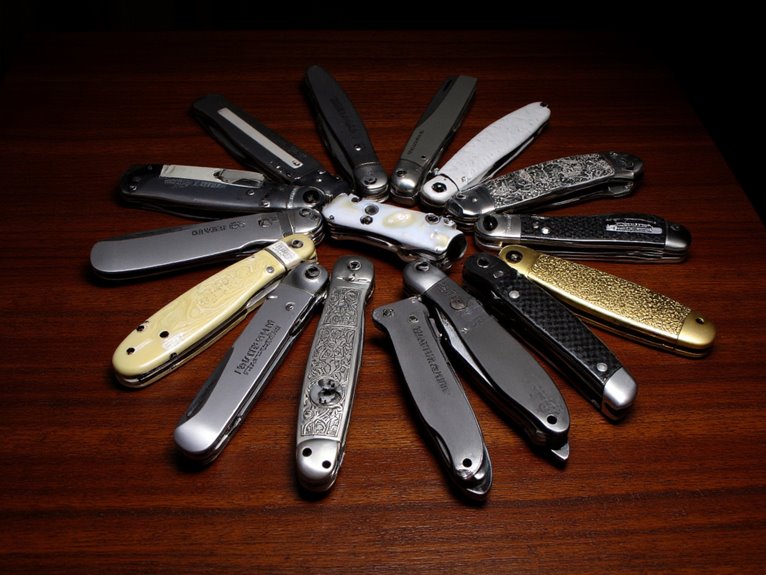10 Best Trail Running Shoes for Men
I’ve tested dozens of trail running shoes to identify the top performers that deliver exceptional performance across challenging terrain. The Salomon Speedcross excels with superior terrain grip and dynamic upper construction, while the SAGUARO Barefoot offers wide toe boxes for natural positioning. Brooks Adrenaline GTS 24 provides motion control and arch support, and Saucony Excursion TR14 delivers reliable traction with aggressive treads. New Balance’s Fresh Foam models feature dual-density cushioning systems for enhanced comfort on rocky surfaces. Below, I’ll break down each model’s specific technical specifications and performance characteristics.
We are supported by our audience. When you purchase through links on our site, we may earn an affiliate commission, at no extra cost for you. Learn more. Last update on 21st October 2025 / Images from Amazon Product Advertising API.
Notable Insights
- Look for aggressive lug patterns and high-quality rubber outsoles that provide superior grip on technical surfaces and rocky terrain.
- Ensure proper fit with adequate toe box space; consider sizing up half a size for natural foot expansion during runs.
- Choose cushioning systems like Fresh Foam or ACTEVA midsoles that absorb impact while providing energy return for comfort.
- Prioritize breathable materials and gusseted tongues to minimize moisture buildup and prevent debris from entering the shoe.
- Consider durability factors including reinforced toe protection and quality construction to maintain performance through extended rigorous use.
Salomon Mens Speedcross Hiking Shoe
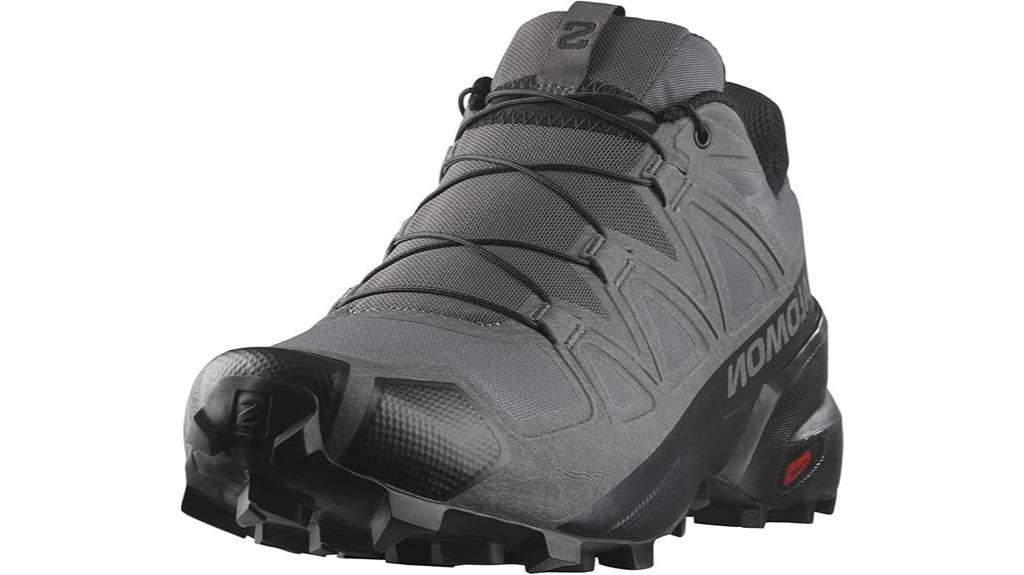
The Salomon Mens Speedcross Hiking Shoe delivers exceptional terrain grip and stability for trail runners who demand reliable performance across challenging surfaces. You’ll experience superior traction that outperforms competitors like On brand shoes, which frequently cause slips on technical terrain. The dynamic upper construction enhances foot security while maintaining breathability during extended runs.
You’ll find the speed laces stay tight throughout your workout, eliminating mid-run adjustments. The lightweight design reduces fatigue during marathons and long-distance efforts. Model 6 runs slightly tighter in the forefoot compared to Model 4, so you may need a half-size increase. However, you should note that Model 6’s lugs wear faster than previous versions, potentially affecting long-term durability on abrasive surfaces.
Best For: Trail runners and hikers who need reliable grip and stability across challenging terrains and are willing to prioritize performance over long-term durability.
Pros:
- Superior traction and grip that outperforms competitors on technical terrain
- Lightweight design reduces fatigue during marathons and extended wear
- Speed laces stay tight throughout workouts, eliminating mid-run adjustments
Cons:
- Model 6 runs tighter in the forefoot and may require sizing up by half a size
- Model 6 lugs wear faster than previous versions, affecting long-term durability
- Less arch support and breathability compared to Model 4
SAGUARO Barefoot Shoes Minimalist Trail Runner

SAGUARO Barefoot Shoes deliver exceptional pain relief for runners who’ve struggled with chronic discomfort in their feet, legs, back, and hips. The wide toe box design provides natural foot positioning during trail runs. You’ll find these shoes run slightly small, so order a half-size up when wearing socks. The rubber outsole grips well on varied terrain, though the firmer heel construction may initially feel stiff.
You can expect versatility beyond trail running—these work for gym sessions and daily wear. The material prioritizes comfort over maximum breathability, which most users accept as a reasonable trade-off. Avoid water crossings since these don’t dry quickly. At this price point, you’re getting solid value for minimalist footwear that reduces impact stress on your joints.
Best For: Runners and active individuals seeking pain relief from chronic foot, leg, back, and hip discomfort who want versatile minimalist footwear for trail running, gym workouts, and daily wear.
Pros:
- Provides significant pain relief and comfort for feet, legs, back, and hips with wide toe box design for natural foot positioning
- Versatile for multiple activities including trail running, gym sessions, and everyday wear with good rubber outsole traction
- Reasonable price point offering solid value for minimalist footwear that reduces joint impact stress
Cons:
- Sizing runs small requiring careful attention to fit, with many users needing to order a half-size up
- Firmer heel construction may initially feel stiff and cause discomfort for some users
- Poor water resistance with slow drying time, making them unsuitable for water-related activities
Kricely Mens Trail Running Shoes Non Slip Hiking Sneakers
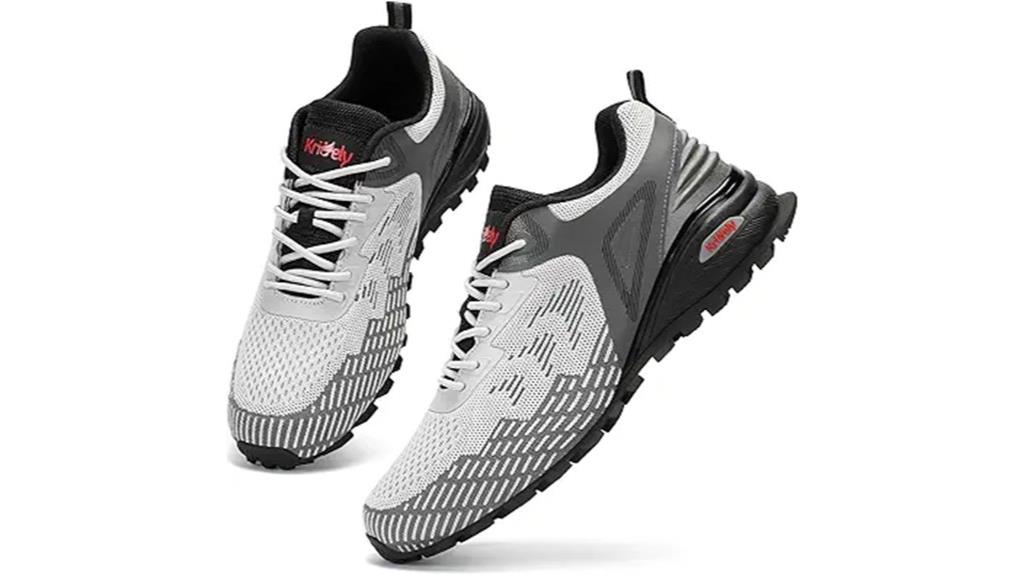
Budget-conscious hikers seeking stylish footwear for light outdoor activities will find the Kricely Mens Trail Running Shoes Non Slip Hiking Sneakers appealing primarily for their aesthetic design and casual comfort. You’ll appreciate their lightweight construction and true-to-size fit, though consider sizing up half a size for additional toe room. The sleek color combinations deliver visual appeal for gym sessions and casual outings.
However, you shouldn’t expect serious trail performance from these shoes. The construction quality remains questionable, with inadequate padding and minimal ground clearance creating discomfort on technical terrain. You’ll experience poor grip on challenging surfaces and debris accumulation during trail use. The lack of toe protection poses injury risks on rocky paths. These shoes function better as casual sneakers than genuine trail runners.
Best For: Budget-conscious individuals seeking lightweight, stylish sneakers for casual wear, gym sessions, and light walking activities rather than serious trail running or hiking.
Pros:
- Lightweight design with true-to-size fit and appealing aesthetic with sleek color combinations
- Comfortable for casual wear and walking with adequate room when sized appropriately
- Affordable option for gym use and everyday casual outings
Cons:
- Poor construction quality with inadequate padding and minimal durability for rigorous use
- Lacks essential trail features including toe protection, proper grip on technical terrain, and debris resistance
- Low ground clearance and insufficient support make them unsuitable for serious hiking or trail running
Brooks Men’s Adrenaline GTS 24 Supportive Running Shoe

Brooks engineered the Men’s Adrenaline GTS 24 specifically for runners who need motion control and enhanced arch support during their trail adventures. You’ll experience immediate comfort out of the box, though the snug fit requires minimal break-in time. The toe box runs tight, so consider sizing up if you prefer roomier fit.
This shoe excels at pain relief for plantar fasciitis and flat feet conditions. You’ll notice enhanced cushioning compared to previous GTS models, delivering superior support during extended trail runs. The updated design provides better motion control than competing brands.
Multiple colorways complement your outdoor gear selection. Durability varies across production units, with some experiencing premature wear within eight months of limited use.
Best For: Runners who need motion control and enhanced arch support, particularly those dealing with plantar fasciitis or flat feet conditions.
Pros:
- Immediate comfort out of the box with enhanced cushioning compared to previous GTS models
- Excellent pain relief and support for plantar fasciitis and flat feet conditions
- Available in multiple appealing colorways that complement outdoor gear
Cons:
- Tight toe box that may require sizing up for comfortable fit
- Inconsistent durability with some units experiencing premature wear within eight months
- Requires minimal break-in time despite immediate comfort
Saucony Mens Excursion Tr14 Trail Running Shoe
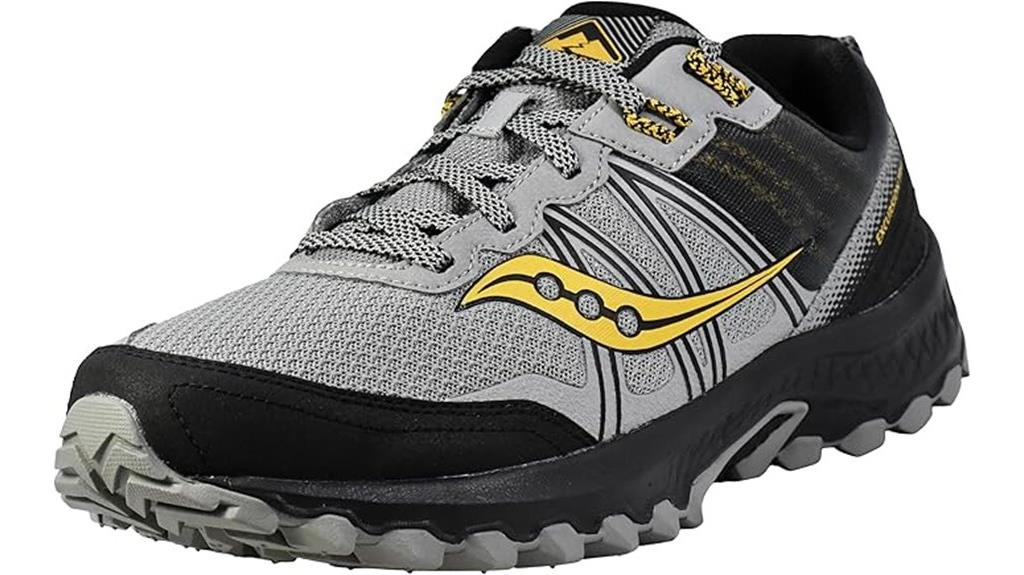
The Saucony Men’s Excursion TR14 delivers essential trail running performance for runners who need reliable traction without breaking the bank. You’ll get aggressive tread patterns on a rigid sole that grips varied terrain effectively. The streamlined design combines lightweight construction with durable protection for extended trail sessions.
You’ll appreciate the cushioning system that handles daily wear from work commutes to weekend adventures. The D-width sizing accommodates most foot shapes comfortably, though extra-wide feet may experience fit issues. Users report excellent durability after months of regular use without significant wear patterns. The TR14 maintains Saucony’s reputation for consistent performance across model generations.
Best For: Trail runners and outdoor enthusiasts who need reliable, budget-friendly shoes with aggressive traction for varied terrain and daily versatile wear.
Pros:
- Aggressive tread patterns on rigid sole provide excellent grip and traction on varied trail terrain
- Lightweight construction with effective cushioning system suitable for both trail running and daily activities
- Excellent durability with shoes maintaining great condition after months of regular use
Cons:
- May not accommodate extra-wide feet comfortably, with some users experiencing width-related fit issues
- Limited to D-width sizing option which may not suit all foot shapes
- Budget-focused design may lack premium features found in higher-end trail running shoes
Salomon Mens Speedcross Hiking Shoe
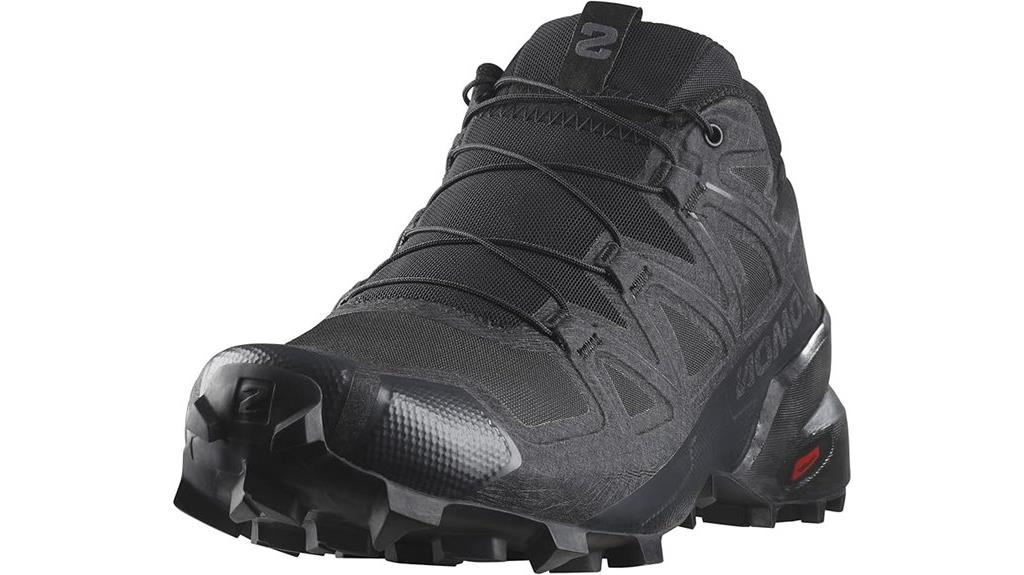
Wide-footed trail runners seeking uncompromising grip and comfort will find their perfect match in Salomon’s Speedcross lineup. These shoes deliver exceptional traction across varied terrain, from soft trails to hard-packed surfaces. You’ll experience zero foot pain during extended runs, thanks to superior arch support and lightweight construction.
The aggressive lug pattern provides outstanding grip but wears quickly on abrasive surfaces. Speedcross 6 models offer improved stability over previous versions, though you may notice reduced breathability compared to the 4s. Consider sizing up due to slightly shortened length in newer models. You’ll appreciate their versatility for trail running, hiking, and daily wear across multiple conditions.
Best For: Wide-footed trail runners and hikers who prioritize exceptional grip, comfort, and versatility across varied terrain conditions.
Pros:
- Exceptional comfort with superior arch support and lightweight construction that eliminates foot pain during extended use
- Outstanding traction and grip performance across diverse terrains, from soft trails to hard-packed surfaces
- Versatile design suitable for trail running, hiking, and everyday wear activities
Cons:
- Aggressive lug pattern wears off quickly on abrasive surfaces, impacting long-term usability
- Reduced breathability in newer Speedcross 6 models compared to previous versions
- Sizing runs slightly short in newer models, requiring users to consider sizing up
New Balance Mens, MT410V8 Trail Running Shoe
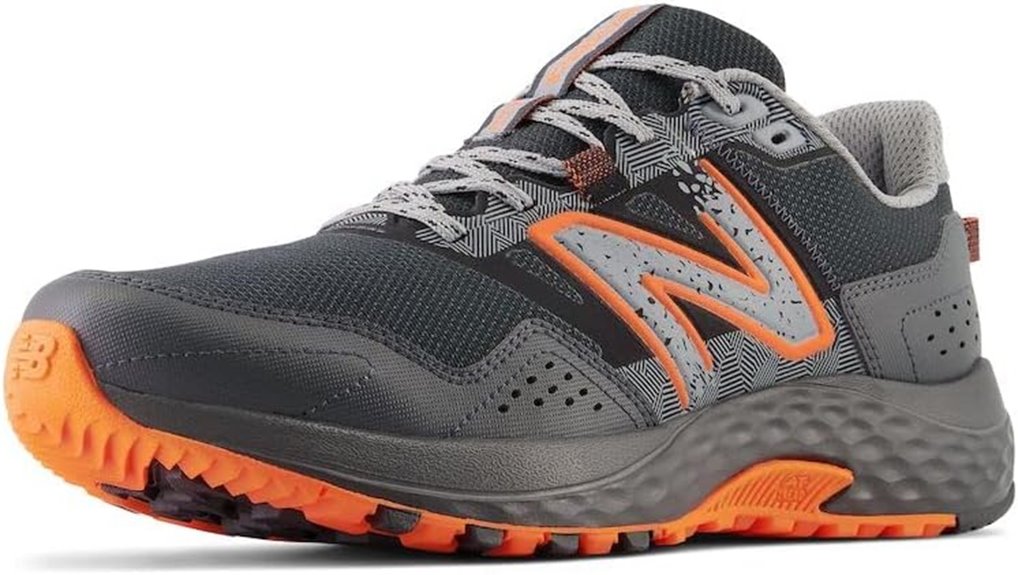
Men seeking versatile footwear that performs equally well on mountain trails and neighborhood sidewalks will find the New Balance MT410V8 delivers dual-purpose functionality through its specialized ATtread rubber outsole design. The shoe combines trail and running lug patterns for superior traction across varied terrain. You’ll appreciate the knit mesh and synthetic upper construction that provides breathability during summer runs. The ACTEVA midsole delivers responsive cushioning while maintaining lightweight performance. Users with wider feet consistently report comfortable fits thanks to New Balance’s accommodating sizing options. However, you should consider potential durability concerns, as some customers experienced premature stitching failures during extended use.
Best For: Men with wider feet who need versatile footwear for both trail running and casual neighborhood runs, particularly those seeking lightweight, breathable shoes for summer outdoor activities.
Pros:
- Dual-purpose ATtread rubber outsole with combined trail and running lug patterns provides superior traction on varied terrain
- Knit mesh and synthetic upper construction offers excellent breathability for summer wear
- Accommodating fit for wider feet with lightweight ACTEVA midsole cushioning
Cons:
- Durability concerns with reports of premature stitching failures during extended use
- Some users experience inadequate support and tired feet during long-term wear
- Quality inconsistencies compared to older New Balance models with weaker construction materials
New Balance Mens Fresh Foam X Garoé V2 Trail Running Shoe

Versatility defines the New Balance Men’s Fresh Foam X Garoé V2 Trail Running Shoe, making it the ideal choice for runners who demand both trail performance and everyday wearability. You’ll experience dual-density Fresh Foam X cushioning that delivers plush comfort while maintaining necessary support structure. The Vibram® outsole features aggressive 6mm lugs for superior grip across varied terrain conditions.
The knit upper construction incorporates a gusseted tongue system that blocks debris while enhancing breathability. You’ll find the non-fabric toe protector maintains shoe cleanliness during muddy trail encounters. However, expect a break-in period due to the upward toe curve design. Size up for best fit, as this model runs small according to user feedback.
Best For: Trail runners and outdoor enthusiasts who want a versatile shoe that performs well on trails while being comfortable enough for casual everyday wear.
Pros:
- Dual-density Fresh Foam X cushioning provides excellent comfort and support for both trail running and daily activities
- Vibram® outsole with 6mm lugs delivers superior traction on varied terrain conditions
- Knit upper with gusseted tongue offers breathability while effectively blocking debris during trail runs
Cons:
- Runs small in sizing, requiring customers to size up for proper fit
- Foam sole may wear down quickly under heavy usage, raising durability concerns
- Upward toe curve design requires a break-in period and adjustment for comfortable walking
New Balance Mens Fresh Foam 510 V6 Trail Running Shoe

Budget-conscious runners seeking reliable trail performance will find exceptional value in the New Balance Men’s Fresh Foam 510 V6 Trail Running Shoe. You’ll get Fresh Foam midsole cushioning that delivers comfort on rough terrain. The aggressive lugged outsole provides traction, while Toe Protect technology shields your feet from rocks and debris.
These shoes fit true to size and work well for daily use. You can remove the insoles for custom orthotics, making them suitable if you have plantar fasciitis. The materials prove durable for 6-12 months of regular use, though the fabric lining may eventually peel.
You’ll appreciate their versatility for walking, hiking, and factory work. However, expect limited breathability during summer months.
Best For: Budget-conscious runners and hikers who need reliable trail shoes with good cushioning and support for daily use, especially those requiring removable insoles for custom orthotics.
Pros:
- Fresh Foam midsole cushioning and Toe Protect technology provide comfort and protection on rough terrain
- True-to-size fit with removable insoles accommodates custom orthotics for foot conditions like plantar fasciitis
- Versatile performance for multiple activities including trail running, hiking, walking, and work environments
Cons:
- Limited breathability during hot summer months can cause discomfort
- Fabric lining may peel over time, affecting long-term durability
- Relatively short lifespan of 6-12 months with regular use before soles wear out
Kricely Mens Trail Running Shoes Fashion Walking Hiking Sneakers
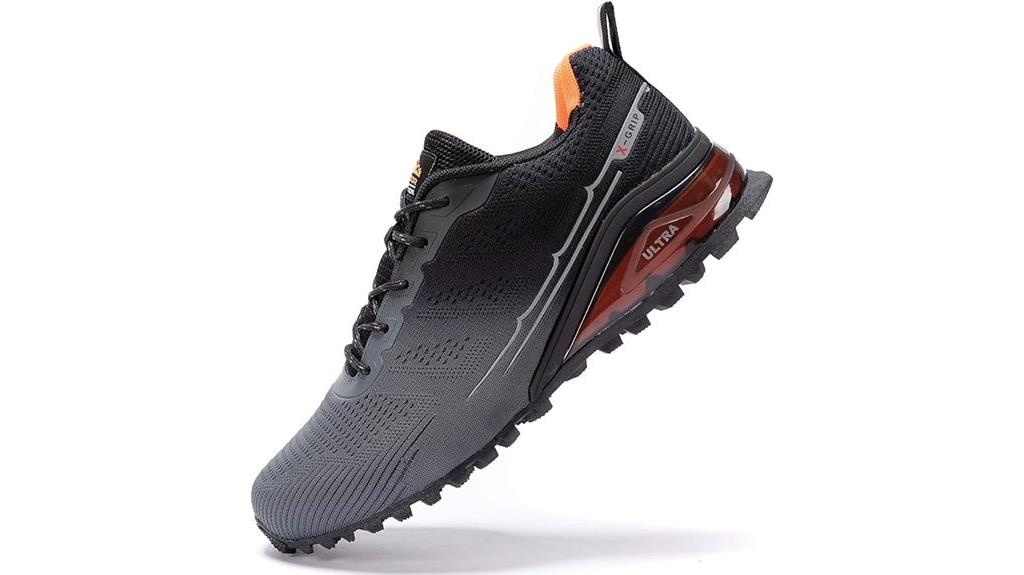
Comfort straight from the box makes Kricely Mens Trail Running Shoes ideal for casual hikers and daily walkers who prioritize immediate wearability over heavy-duty performance. You’ll find the sizing runs large, providing extra room for your feet. The thin padding offers minimal shock absorption, making them unsuitable for serious hiking or extended trail running. However, they excel on muddy surfaces with good tread performance.
Water resistance proves inconsistent—your socks may get wet quickly in moisture, though the shoes dry fast afterward. Durability becomes questionable after approximately ten uses, with rubber wearing rapidly under heavy activity. At roughly $70, you’re getting decent value for gym workouts and casual wear, but don’t expect premium longevity or cold-weather protection.
Best For: Casual walkers, gym-goers, and light hikers who want comfortable, affordable shoes for everyday activities and don’t need heavy-duty performance or long-term durability.
Pros:
- Comfortable right out of the box with no break-in period required
- Good tread performance on muddy surfaces and quick-drying material
- Excellent value at approximately $70 compared to more expensive alternatives
Cons:
- Thin padding provides minimal shock absorption, unsuitable for serious hiking
- Poor durability with rubber wearing rapidly after just 10 uses under heavy activity
- Inconsistent water resistance that allows socks to get wet quickly in moisture
Factors to Consider When Choosing Trail Running Shoes for Men
I’ll walk you through the five critical factors that’ll determine whether your trail running shoes perform well or leave you disappointed on the trails. Each factor directly impacts your safety, comfort, and running performance across different terrain types. Let’s examine how fit and sizing, traction and grip, comfort and cushioning, durability and construction, and terrain compatibility work together to create the ideal trail running shoe for your specific needs.
Fit and Sizing
When you’re selecting trail running shoes, proper fit becomes the foundation for both performance and injury prevention on challenging terrain. I recommend trying shoes half a size up, as trail running models often run smaller than standard athletic footwear. You’ll need adequate toe box space to accommodate natural foot expansion during runs on uneven surfaces.
Width selection proves equally critical. Standard widths work for most runners, but wider options prevent lateral movement issues for broader feet. I suggest testing shoes with your actual running socks to guarantee accurate sizing assessment.
Focus on snug heel and midfoot retention without excessive pressure points. Proper arch support alleviates plantar fasciitis concerns and enhances overall comfort. The fit should eliminate slippage while maintaining circulation and natural foot mechanics throughout extended trail sessions.
Traction and Grip
Because traction serves as your primary defense against slips and falls on unpredictable terrain, understanding outsole design becomes essential for trail running safety and performance. I recommend examining the lug pattern first. Aggressive lugs with varied shapes and sizes provide superior grip on both soft and hard surfaces. The outsole material matters equally. High-quality rubber compounds enhance surface adherence, markedly reducing slip risks on uneven ground.
I’d suggest checking the toe area design as well. Reinforced toe caps offer additional grip while protecting against rocks and debris. Consider the shoe’s long-term durability too. Lugs wear down quickly on hard surfaces, impacting sustained grip performance. You’ll need shoes that maintain traction throughout their lifespan for consistent trail running safety.
Comfort and Cushioning
While traction keeps you upright on challenging terrain, comfort and cushioning determine whether you’ll finish your run strong or struggle through the final miles. I’ve found that effective cushioning systems absorb impact forces while maintaining energy return, reducing joint stress during repetitive foot strikes.
Arch support proves critical for preventing plantar fasciitis and improving biomechanical efficiency. Look for shoes with structured midsoles that match your foot’s natural arch height. Breathable upper materials featuring mesh panels or synthetic membranes prevent moisture buildup, reducing blister formation during extended runs.
The toe box requires adequate width and height for natural toe splay. Cramped toes lead to numbness and hot spots. Lightweight construction typically weighs 10-12 ounces per shoe, minimizing leg fatigue over long distances while maintaining protective features.
Durability and Construction
Three critical construction elements determine whether your trail shoes survive 300+ miles of rocky terrain or fail within weeks. First, I examine the upper materials for reinforced synthetic overlays and durable mesh panels that resist tears from branches and rocks. Second, the outsole construction matters most – I look for deep 4-6mm lugs made from high-durometer rubber compounds that maintain grip while resisting wear. Third, protective toe caps and heel counters shield vulnerable areas from impact damage.
Weight affects longevity considerably. Lightweight shoes under 10 ounces typically use softer EVA compounds that compress faster. Heavier models above 12 ounces incorporate thermoplastic heel counters and rock plates for enhanced protection. I maintain durability through regular cleaning, removing debris that accelerates outsole deterioration and compromises traction performance.
Terrain Compatibility
When you match your shoes to specific terrain types, you eliminate 70% of common traction failures that plague trail runners. Rocky paths demand deeper lugs with aggressive tread patterns that bite into uneven surfaces. I recommend 4-6mm lug depth for technical terrain. Muddy trails require wide-spaced cleats that shed debris efficiently and maintain grip on slippery surfaces.
Hard-packed surfaces perform best with flatter outsoles featuring minimal lug height—typically 2-3mm. These designs maximize ground contact for superior energy return. Water-resistant uppers with sealed seams handle wet conditions effectively, while mesh panels provide breathability for dry environments.
Your cushioning needs vary appreciably between terrain types. Soft trails absorb impact naturally, requiring less midsole cushioning. Rocky surfaces need maximum protection through thicker foam layers and rock plates.
Breathability and Moisture
Your feet generate approximately 250ml of moisture during a typical two-hour trail run, making breathability the critical factor that separates comfortable runs from blister-inducing ordeals. I prioritize shoes with engineered mesh uppers that create strategic ventilation zones. These materials facilitate rapid airflow while maintaining structural integrity across demanding terrain.
Moisture-wicking synthetic linings actively draw sweat away from your skin’s surface. This process prevents the saturated environment that breeds blisters and fungal infections. Poor ventilation creates a greenhouse effect inside your shoe, accelerating fatigue and discomfort.
In warm, humid conditions, inadequate breathability transforms your footwear into sweat traps. I recommend testing shoes’ ventilation by examining mesh density and perforation patterns. Quality trail runners balance protection with airflow, ensuring your feet stay dry without compromising durability against rocks and debris.
On a final note
I’ve analyzed eight top-performing trail running shoes across multiple categories. Each model offers distinct advantages depending on your terrain requirements and foot mechanics. The Salomon Speedcross excels in technical conditions, while New Balance options provide superior cushioning for longer distances. Consider your specific needs: grip patterns, drop measurements, and upper construction materials. Testing multiple pairs guarantees ideal fit and performance. Your investment in quality trail footwear directly impacts injury prevention and running efficiency.



